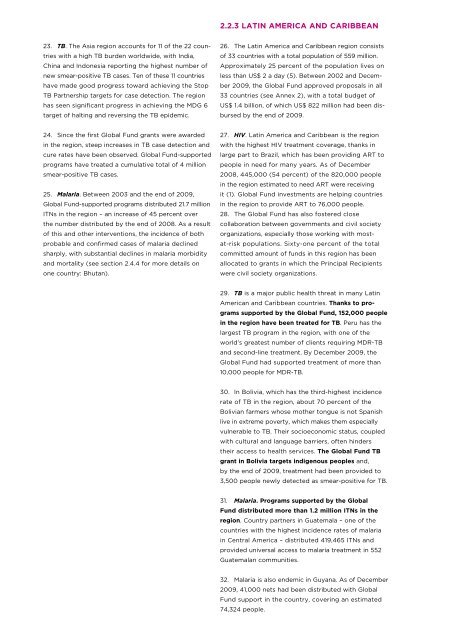Global Fund: Progress Report 2010 - unaids
Global Fund: Progress Report 2010 - unaids
Global Fund: Progress Report 2010 - unaids
Create successful ePaper yourself
Turn your PDF publications into a flip-book with our unique Google optimized e-Paper software.
2.2.3 LATIN AmerICA ANd CarIBBEAN<br />
23. TB. The Asia region accounts for 11 of the 22 countries<br />
with a high TB burden worldwide, with India,<br />
China and Indonesia reporting the highest number of<br />
new smear-positive TB cases. Ten of these 11 countries<br />
have made good progress toward achieving the Stop<br />
TB Partnership targets for case detection. The region<br />
has seen significant progress in achieving the MDG 6<br />
target of halting and reversing the TB epidemic.<br />
26. The Latin America and Caribbean region consists<br />
of 33 countries with a total population of 559 million.<br />
Approximately 25 percent of the population lives on<br />
less than US$ 2 a day (5). Between 2002 and December<br />
2009, the <strong>Global</strong> <strong>Fund</strong> approved proposals in all<br />
33 countries (see Annex 2), with a total budget of<br />
US$ 1.4 billion, of which US$ 822 million had been disbursed<br />
by the end of 2009.<br />
24. Since the first <strong>Global</strong> <strong>Fund</strong> grants were awarded<br />
in the region, steep increases in TB case detection and<br />
cure rates have been observed. <strong>Global</strong> <strong>Fund</strong>-supported<br />
programs have treated a cumulative total of 4 million<br />
smear-positive TB cases.<br />
25. Malaria. Between 2003 and the end of 2009,<br />
<strong>Global</strong> <strong>Fund</strong>-supported programs distributed 21.7 million<br />
ITNs in the region – an increase of 45 percent over<br />
the number distributed by the end of 2008. As a result<br />
of this and other interventions, the incidence of both<br />
probable and confirmed cases of malaria declined<br />
sharply, with substantial declines in malaria morbidity<br />
and mortality (see section 2.4.4 for more details on<br />
one country: Bhutan).<br />
27. HIV. Latin America and Caribbean is the region<br />
with the highest HIV treatment coverage, thanks in<br />
large part to Brazil, which has been providing ART to<br />
people in need for many years. As of December<br />
2008, 445,000 (54 percent) of the 820,000 people<br />
in the region estimated to need ART were receiving<br />
it (1). <strong>Global</strong> <strong>Fund</strong> investments are helping countries<br />
in the region to provide ART to 76,000 people.<br />
28. The <strong>Global</strong> <strong>Fund</strong> has also fostered close<br />
collaboration between governments and civil society<br />
organi zations, especially those working with mostat-risk<br />
populations. Sixty-one percent of the total<br />
committed amount of funds in this region has been<br />
allocated to grants in which the Principal Recipients<br />
were civil society organizations.<br />
29. TB is a major public health threat in many Latin<br />
American and Caribbean countries. Thanks to programs<br />
supported by the <strong>Global</strong> <strong>Fund</strong>, 152,000 people<br />
in the region have been treated for TB. Peru has the<br />
largest TB program in the region, with one of the<br />
world’s greatest number of clients requiring MDR-TB<br />
and second-line treatment. By December 2009, the<br />
<strong>Global</strong> <strong>Fund</strong> had supported treatment of more than<br />
10,000 people for MDR-TB.<br />
30. In Bolivia, which has the third-highest incidence<br />
rate of TB in the region, about 70 percent of the<br />
Bolivian farmers whose mother tongue is not Spanish<br />
live in extreme poverty, which makes them especially<br />
vulnerable to TB. Their socioeconomic status, coupled<br />
with cultural and language barriers, often hinders<br />
their access to health services. The <strong>Global</strong> <strong>Fund</strong> TB<br />
grant in Bolivia targets indigenous peoples and,<br />
by the end of 2009, treatment had been provided to<br />
3,500 people newly detected as smear-positive for TB.<br />
31. Malaria. Programs supported by the <strong>Global</strong><br />
<strong>Fund</strong> distributed more than 1.2 million ITNs in the<br />
region. Country partners in Guatemala – one of the<br />
countries with the highest incidence rates of malaria<br />
in Central America – distributed 419,465 ITNs and<br />
provided universal access to malaria treatment in 552<br />
Guatemalan communities.<br />
32. Malaria is also endemic in Guyana. As of December<br />
2009, 41,000 nets had been distributed with <strong>Global</strong><br />
<strong>Fund</strong> support in the country, covering an estimated<br />
74,324 people.

















